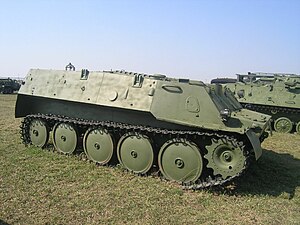GT-MU
| GT-MU | |
|---|---|

GT-MU in a Russian museum (2008) |
|
| General properties | |
| crew | 2 |
| length | 5146 mm |
| width | 2470 mm |
| height | 1700 mm |
| Dimensions | 5.8 tons |
| Armor and armament | |
| Armor | 6 mm |
| agility | |
| drive | Four-cylinder carburetor engine GAS-73 83 kW (113 PS) |
| suspension | Torsion bar suspension |
| Top speed | 55 km / h (road), 5 to 6 km / h (in water) |
| Power / weight | |
| Range | 500 km (road) |
GT-MU is the name of an all-terrain, lightly armored and floatable caterpillar vehicle developed in the former Soviet Union . The vehicle developed in the Gorkowski Avtomobilny Sawod is a further development of the GT-SM . The vehicle is primarily used in the airborne troops as a transport armor and carrier for special vehicles.
development
The GT-MU was derived from the unarmored GT-SM developed in the 1960s at the Gorki automobile plant. The reason was the need for a small, light, but armored and all-terrain transport vehicle for the airborne troops. The basic construction was adopted, but the hull was welded from armored steel. Series production began in 1971 in Zavolzhye (Заволжский завод гусеничных тягачей).
construction
The hull of the vehicle is welded from armor steel with a thickness of six millimeters. The armor protects the crew from rifle weapons and shrapnel. The tub, which is closed on all sides, is divided into several compartments separated from each other by partition walls. The driver and the commander find their place in the bow of the vehicle. Both can observe the area in front of them through large viewing windows, which can be closed with armored plates if necessary, then observation takes place via an angle mirror . Immediately afterwards there is the engine compartment, followed by the cargo area, which can hold six to ten soldiers or payloads. Access to the vehicle is through two hatches in the rear wall of the fighting compartment and for the driver and commander through hatches on the tub.
The four-cylinder GAS-73 carburettor engine, which is also used in the GT-SM and has an output of 113 hp, was originally used as the engine. In the version GT-MU-1D (ГТ-МУ-1Д) the air-cooled supercharged diesel engine GAS-5441.10 is installed, which makes 173 HP. The change gear has four forward and one reverse gears.
The caterpillar drive has five large rollers on each side that are spring-loaded with torsion bars. The last roller on each side also serves as a guide wheel, which is also used to tension the chain. The drive wheel is in the front. The spring travel of all rollers is limited by rubber buffers, and the first and last rollers are also limited by internal telescopic shock absorbers. In the water, the GT-MU is driven by the crawler tracks.
Modifications
GT-MU-1D
Version with charged diesel engine.
Versions
The GT-MU serves as the base vehicle for a number of military systems.
RChM-2
Chemical reconnaissance vehicle.
SPR-1
The SPR-1 (1L21 / 1) is a radio measuring fuse interference station. The station emits targeted impulse-response interference in order to detonate projectiles and grenades with radio-assisted proximity detonators.
commitment
The GT-MU and the vehicles based on it are primarily used by airborne troops in the Soviet Army . Weight and dimensions are advantageous here, as they enable transport in transport aircraft such as the Antonov An-12 or the Ilyushin Il-76 .
The National People's Army (NVA) used the GT-MU only in very small numbers. The use of the radio measuring fuse interference station SPR-1 is known from 1988 onwards. In each of the companies for radio electronic combat three vehicles were planned, but until 1989 only two vehicles in total were procured. The units, also known colloquially as radio interference companies, were to be set up with the STAN-95 in all divisions of the NVA, but until 1989 only the 8th and 11th motorized rifle divisions took the new structure.
Individual evidence
- ↑ all information according to ГТ-МУ-1Д - транспортер-тягач
- ↑ see cook
Web links
- ГТ-МУ-1Д - транспортер-тягач (Russian)
- Missile and Weapons Service in Kdo.MB III, technical catalog, radio measuring fuse destruction station SPR-1 (1L21 / 1)
literature
- Ю. Н. Вараксин, И. В. Бах, С. Ю. Выгодский: Бронетанковая техника СССР (1920–1974). ЦНИИ Информации, 1981. (Russian)
- Fred Koch: Armored vehicles of the GDR, part 8. In: Tankograd military vehicle. Edition 1/2006.